
5 Benefits of Oil Pulling You Didn’t Know
In the quest for better dental health, we often find ourselves exploring various oral care methods. One such ancient practice gaining modern recognition is oil pulling. Originating from Ayurveda, the traditional medicine system of India, oil pulling involves swishing oil around in the mouth for a set period. While it may seem simple, the benefits extend far beyond regular dental hygiene practices.
In this article, we will explore five surprising advantages of oil pulling that you might not have known.
How Oil Pulling Works?
During the oil-pulling process, the oil binds to the biofilm of your teeth—a thin layer consisting of bacteria and other microorganisms. The biofilm serves as an early indicator of plaque formation and can lead to various dental issues, including
- Cavities,
- Gum disease,
- Sensitive teeth,
- Gum inflammation.
The lipid structure within the oil then binds with the bacteria’s cell wall lipoproteins, and as you rinse your mouth, it effectively flushes the bacteria out. By regularly including oil pulling into your oral care routine, you can actively contribute to maintaining a cleaner and healthier mouth.
How To Do Oil Pulling?
Oil pulling is a simple and ancient oral care practice that involves swishing oil in the mouth to promote oral hygiene and overall health. Here’s a step-by-step guide on how to do oil pulling:
Step 1: Choose Your Oil:
Select an edible oil for oil pulling. Common choices include coconut oil, sesame oil, and olive oil. Coconut oil is popular due to its pleasant taste and additional antimicrobial properties. Sesame oil is advised to be the perfect fit by doctors in Lakshme Dental as it has more benefits and anti-inflammatory properties.
Step 2: Measure the Oil:
Take about 5 ml of the oil of your preference. If it’s solid (like coconut oil), you may need to melt it first by warming it slightly.
Step 3: Begin Swishing:
Start swishing the oil around in your mouth. Do this gently. If you’re new to oil pulling, you can start by swishing the oil for 2 to 5 minutes, adjusting the duration based on your comfort level.
Step 4: Swish Thoroughly:
Swish the oil through your teeth and around your mouth. Pull the oil between your teeth and allow it to reach all areas, including the front and back of your mouth.
Step 5: Avoid Swallowing:
As you swish, the oil will mix with saliva and turn thinner. It’s essential not to swallow the oil during this process, as it now carries the bacteria and toxins you are trying to remove.
Step 6: Spit Out the Oil:
After the recommended time, spit out the oil.
Step 7: Rinse and Brush:
Rinse your mouth thoroughly with warm water or a saltwater solution. Doctors recommend following up on oil pulling with regular brushing as the process is a part of dental hygiene.
Step 8: Timing Matters:
While oil pulling can be done at any time of the day, many people prefer to do it in the morning before eating or drinking anything. This allows for the removal of toxins that may have accumulated overnight. Doing it before brushing is recommended for better results.
Tips For Oil Pulling:
- Be consistent. For favorable results, make oil pulling a daily habit.
- If you find it challenging to do for the entire recommended time, start with a shorter duration and gradually increase it.
- Try out various oils to discover your preferred choice.
- Oil pulling is a complement to regular oral care, not a substitute.
The steps to practice consistent oil pulling and regular oral care practices can enhance the aesthetics of your smile. It’s always a good idea to consult with your dentist or healthcare professional if you have any concerns or specific oral health conditions.
Benefits of Oil Pulling
1. Detoxification and Oral Cleansing
Oil pulling serves as a natural detoxification process for the oral cavity. The swishing action helps to remove
- toxins,
- bacteria, and
- other harmful microorganisms from the gums and teeth.
The oil acts as a magnet for these impurities, preventing them from settling and causing potential damage.
2. Stops Gum Diseases
Plaque, the sticky film of bacteria that forms on teeth, is a common dental concern. If not addressed properly, plaque can harden into tartar, leading to gum inflammation and, eventually, more severe conditions like gingivitis. Oil pulling is effective in reducing plaque buildup and gingivitis.
A study published in the Journal of Indian Society of Pedodontics and Preventive Dentistry revealed that oil pulling with sesame oil significantly reduced plaque. The swishing action helps remove bacteria and plaque from your teeth, promoting better oral health and preventing gum diseases.
3. Teeth Whitening and Brightening
While not a substitute for professional teeth whitening treatments, oil pulling can contribute to a brighter and whiter smile. The process helps remove surface stains and discoloration from the teeth, resulting in a brighter appearance. The oil’s natural properties assist in breaking down stains, particularly those caused by certain foods and beverages. It’s essential to note that the degree of whitening may vary among individuals, and results are generally subtle compared to professional whitening treatments.
4. Reduces Bad Breath (Halitosis)
Persistent bad breath, or halitosis, can be a source of social discomfort and may indicate underlying oral health issues. Oil pulling offers a solution to combat bad breath by addressing its root causes. The swishing action helps eliminate the bacteria responsible for foul odors, providing a natural and long-lasting solution. The antimicrobial properties of the oil contribute to a healthier oral microbiome, reducing the likelihood of unpleasant odors.
5. Fights Dental Caries & Inflammation
Oil pulling also has significant effects on dental caries caused by bacteria. Research suggests that the reduction of oral inflammation and bacteria through practices like oil pulling may have positive effects on overall dental health. Practicing it as a daily routine can reduce the viability of the microorganisms and prevent
- Cavities,
- Sores inside mouth (Mouth ulcers),
- Bleeding gums,
- Tongue ulcers.
To Conclude
The Oil pulling practice has surprising benefits that extend beyond dental hygiene. From detoxification and plaque reduction to teeth whitening and gum health. Including oil pulling into your routine can contribute to a healthier and brighter smile. And it’s advisable to consult with a dental professional for your oral care routine to your specific needs. Embrace the ancient wisdom of oil pulling and unlock the hidden wonders for a healthier, more vibrant smile.










